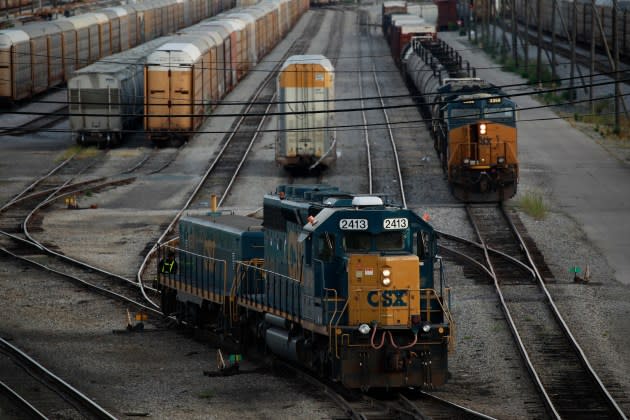CSX may be at a crossroads in the wake of the merger announcement of two of its Class I railroad rivals.
Activist investor Ancora Holdings, which launched a proxy fight against Norfolk Southern that sparked a board overhaul and resulted in the ousting of its then-chair, could use its sway to push CSX in a new direction. One such option may be a potential merger.
More from Sourcing Journal
In a Wednesday interview with CNBC, Ancora Alternatives president James Chadwick said that the hedge fund has been a “growing shareholder” in CSX, although the asset management firm has not disclosed its stake.
“[CSX] has to make a decision of whether it wants to find a merger partner or whether it’s going to have to go retool management,” Chadwick said.
When asked if Ancora would consider a campaign against CSX management, Chadwick said “I think that’ll be up to CSX, ultimately.”
Chadwick denied that there had been contact with CSX regarding a possible activist push yet, but said “Whatever actions they make from here will dictate what we do.”
In a late July earnings call, CSX CEO Joseph Hinrichs did not rule out the possibility of a merger or acquisition, saying the company was “always open to anything” to deliver shareholder value.
Ancora’s potential move could be summed up by Chadwick’s criticism that the company is “underperforming,” particularly in operating ratio.
Operating ratio is a top performance metric monitored by analysts, representing operating costs divided by total revenue. The data point typically reflects a railroad’s ability to manage its expenses and drive profits, and is expressed as a percentage. The lower the percentage, the better the railroad is at generating profits.
Currently, CSX has the worst operating ratio of the Class I railroads at 64.1 percent. In the quarter prior to Hinrichs’ start as CEO and president in September 2022, the railroad had a 55.4 percent operating ratio.
The conclusion of Ancora’s proxy fight with Norfolk Southern last year also involved the operating ratio metric. At the time, the railroad said it planned to reach a sub-60 percent operating ratio within three to four years.
Whether Ancora’s overtures have gotten to CSX or not, it appears there may be more movement on the railroad’s part to enact some level of change.
On Thursday, a Bloomberg report said CSX is working with Goldman Sachs as the railroad potentially explores its options. The railroad spoke with the bank about the possibilities of a merger, the report said.
CSX did not have additional comment on the report.
Before the $85 billion Union Pacific-Norfolk Southern acquisition, reports had surfaced that BNSF Railway was seeking to acquire a rival railroad, and that it tapped Goldman Sachs to get such a deal in motion.
However, Warren Buffett, the investing icon who chairs BNSF parent Berkshire Hathaway, had swatted away the Goldman connection, indicating that no one from the investment bank had spoken to him about a possible deal.
Given the national implications of a UP-NSC merger, a combination of their respective rivals in the Western and Eastern U.S. would make sense.
BNSF Railway covers 32,500 route miles in 28 states and three Canadian provinces, while CSX reaches more than 20,000 route miles across 26 states, Washington, D.C. and two provinces. Like Union Pacific and Norfolk Southern, there is minimal overlap between BNSF and CSX, with the only common areas being Midwestern cities like Chicago, St. Louis, Memphis and New Orleans.
With the chatter about the future of CSX and BNSF likely going to linger, the Union Pacific-Norfolk Southern takeover has caught attention of a top U.S. lawmaker railing against the deal.
Senate Democratic Leader Chuck Schumer cited the acquisition as one that pushes the industry “further down the road of dangerous consolidation and monopoly power.”
“The last four decades of railroad mergers have led to worse service, worse safety, worse working conditions, higher costs for shippers—which ultimately means higher prices for consumers,” Schumer argued. “They also promise no union jobs will be cut. But we’ve heard that before, from the same executives who’ve laid off thousands of workers while raking in record profits.”
Schumer pointed to union opposition to the deal, including that from the SMART Transportation Division, which is the largest railroad union in America.
The Union Pacific-Norfolk Southern acquisition is expected to close by early 2027, if it passes the regulatory approval process of the Surface Transportation Board (STB). The deal would cut the number of U.S.-headquartered Class I railroads from four to three, while a possible BNSF-CSX merger would cut that number to two.
Terms and Privacy Policy
Yahoo News – Latest News & Headlines
Read the full article .


